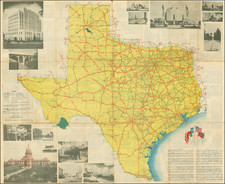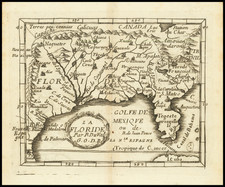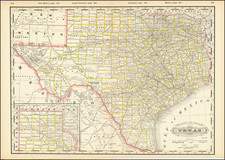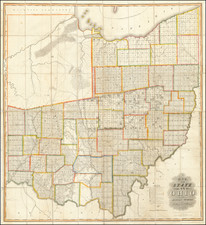Rare 1701 First Edition
Nice example of this historically important and fascinating map of the Gulf Coast and Mississippi River region, from Nicolas De Fer's Atlas Curieux.
In preparing this fine map, the leading French cartographer Nicolas De Fer (1646-1720) drew upon the manuscript maps of Jean-Baptiste-Louis Franquelin, Guillaume De L'Isle and others. Importantly, the map labels the fort at Biloxi, Mississippi erected by Pierre le Moyne d'Iberville in 1699, founder of Louisiana, who explored the interior of North America in the service of Louis XIV, in order to defeat Spanish claims to the Mississippi Valley. Also included is La Salle's information on his exploration south from Canada. La Salle was convinced the Mississippi River flowed close to the Spanish mines in Mexico, making them accessible to the French. The map shows early detail in Texas relating to La Salle's explorations and along the Gulf Coast and Southeastern Seaboard.
Pierre Le Moyne d'Iberville (1661-1706) was a French Canadian explorer and soldier and one of the most important figures in the early history of the U.S. Gulf Coast. He was the founding father of Louisiana and is credited with establishing Biloxi, Mississippi and Mobile, Alabama. He was notably one of the first of the America's great adventurers to be born in the New World.
Iberville was born in Montreal, New France (Quebec, Canada), one of twelve sons of Charles Le Moyne, a merchant from Dieppe, France and Catherine Thierry. Several of Iberville's brothers were important figures in their own right, and some participated in his ventures.
Iberville received a fine education at Montreal's Sulpician Seminary, including instruction in mathematics, skills that would later be useful for navigation. At the age of 12, he sailed to Nova Scotia as part of a mercantile voyage and a few years thereafter joined a team of 'couriers du bois' as they canoed to Lake Superior.
From 1686 to 1697, the French mounted aggressive campaigns against the English presence in the American Colonies and in Hudson's Bay in northern Canada. In 1686, Iberville was a leading member of Pierre de Troyes' expedition that captured the English forts of Moose Factory and Fort Rupert. In 1690, he participated in the Schenectady Massacre, a combined French-Algonquin attack on English settlements in the Mohawk Valley of New York. In 1696, Iberville captured the English settlements of Pemaquid, Maine and St. John's, Newfoundland. In 1697, he seized the important outpost of York Factory, dealing a severe long-term blow to English operations in Hudson's Bay.
Following the war with England, Iberville's stellar military service ensured that he was chosen to lead a mission of the utmost consequence to the future of New France and what would alter be known as the U.S. Gulf Coast.
In 1682, René-Robert Cavelier, Sieur de La Salle became the first European to travel from the Great Lakes down the Mississippi to the Gulf of Mexico. La Salle claimed the Mississippi Valley and the coast of the Gulf of Mexico near the river's mouth for France, christening it 'Louisiana'. From that time onwards, the French harbored ambitions of building a great American Empire linking Canada to the Gulf of Mexico. This vision was hindered by the fact that La Salle's untimely death ensured that the French were unaware of the true location of the mouth of the Mississippi River. Moreover, Spain maintained a rival claim to the region, such that France would have to stake a permanent presence if their claim to Louisiana was to endure.
Louis Phélypeaux, Comte de Pontchartrain, the French colonial minister charged Iberville with the critical mission of relocating the mouth of the Mississippi River and building a permanent French settlement in the region. In October 1698, Iberville left Brest, France with four ships in October 1698. In March of the following year, he successfully located the mouth of the Mississippi River, a discovery confirmed by Native Americans who recalled meeting La Salle.
Not finding any good locations near the Mississippi Delta, Iberville headed east along the Gulf Coast, building the fort at Biloxi, or Bilocci (Biloxi, Mississippi) in 1699. There he left a garrison of 81 men, before returning to France. Iberville returned to Biloxi in 1700, before proceeding 40 miles up the Mississippi River to build Fort Maurepas. During a third voyage in 1701, Iberville founded Mobile, Alabama.
Iberville's discoveries and the trio of forts he established legitimized France's claims to the Mississippi Valley and the Gulf Coast from Alabama to Texas. In this sense, Iberville was the founder of what would become the states of Louisiana, Mississippi and Alabama.
Iberville died in 1706 in Havana while planning an attack on Charleston, South Carolina. However, his efforts to build a great Franco-American Empire, extending from Canada to the Gulf, were consolidated by Iberville's younger brother, Jean-Baptiste Le Moyne de Bienville, who founded New Orleans in 1719.
Nicholas de Fer (1646-1720) was the son of a map seller, Antoine de Fer, and grew to be one of the most well-known mapmakers in France in the seventeenth century. He was apprenticed at twelve years old to Louis Spirinx, an engraver. When his father died in 1673, Nicholas helped his mother run the business until 1687, when he became the sole proprietor.
His earliest known work is a map of the Canal of Languedoc in 1669, while some of his earliest engravings are in the revised edition of Methode pour Apprendre Facilement la Geographie (1685). In 1697, he published his first world atlas. Perhaps his most famous map is his wall map of America, published in 1698, with its celebrated beaver scene (engraved by Hendrick van Loon, designed by Nicolas Guerard). After his death in 1720, the business passed to his sons-in-law, Guillaume Danet and Jacques-Francois Benard.












![Comparative Size of Lakes and Islands [Great Lakes, Cuba, Formosa, Ireland, Sicily, Cyprus, Vancouver, Sandwich Islands, Puerto Rico, Corsica, Sardinia, Balearics, Malta, etc]](https://storage.googleapis.com/raremaps/img/small/100135.jpg)


